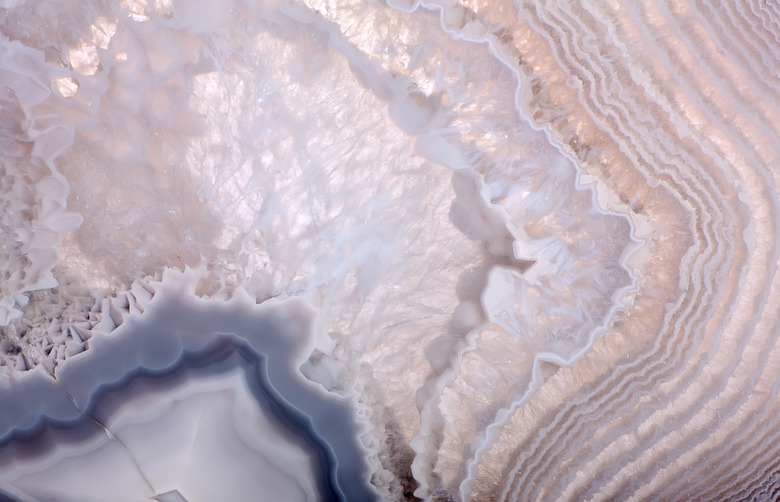How To Find Gold In Quartz
In its original form, gold appears in igneous volcanic hydrothermal (hot water) veins where it is deposited along with quartz, amethyst, other minerals and heavy metal ores. The "Mother Lode" of gold in California is a region crisscrossed by many such quartz-and-gold-filled hydrothermal veins. Nearly all hydrothermal quartz veins everywhere contain some amount of gold. To find the gold, first find the quartz.
Look Upstream From Known Gold Locations
Look Upstream From Known Gold Locations
A good place to look for gold-bearing quartz rocks is to go where other miners and prospectors have already been. Even rocks that have been passed over by other prospectors as well as gold mine tailings (leftovers) may contain gold. Fortunes have been made by patiently and systematically reworking the leftovers and tailings of fly-by-night and slash-and-grab gold prospectors and miners. Large corporate efforts to extract gold often leave behind gold that is more efficiently and cost-effectively extracted by small-time miners and weekend prospectors.
Generally, gold originates upstream from places where it is actively panned or has been historically panned and sluiced from sand and gravel deposits. Look for gold and gold-containing quartz rocks in areas where volcanic hydrothermal activity has taken place in the geologic past. These areas include the regions around old gold mines and rock outcrops upstream from placer gold deposits where gold has eroded out of its bedrock, washed downstream and accumulated in and near stream channels.
Examine Rock Outcrops and Fractures
Examine Rock Outcrops and Fractures
Rock outcrops and rocky areas are often good places to find a lot of quartz. Quartz appears in a variety of colors (including amethyst) depending on the mineral impurities it contains. Quartz has a massive crystalline appearance and can be white, yellow, pink, purple, grey or black. Gold occurs in between the other crystals found in quartz.
Look for gold in quartz veins in areas where the bedrock is fractured by tectonic and volcanic activity. Fractures and cracks in the bedrock form ideal pathways for superheated water and steam under pressure to flow and to precipitate out their dissolved mineral and heavy metal loads. Gold is deposited by precipitation along the fracture edges and walls. Active geyser basins and old extinct geysers are evidence of such hydrothermal activity.
Use a Metal Detector
Use a Metal Detector
Use a metal detector to look for gold in quartz bearing rocks. Any large gold crystal pieces (nuggets) or veins of gold will give a good strong signal on most metal detectors. But just because you might not get a strong signal does not mean that gold is not there. Conversely strong metal detector signals may indicate the presence of other metals besides gold. Fortunately, when metals are present in quartz veins, gold is usually among them.
Examining the Quartz for Gold
Examining the Quartz for Gold
Look for natural cracks and lines in the quartz rocks that you find and examine them carefully because gold often occurs along such linear structures. Gold is easy to spot in white quartz. Use your geology hammer and sledge to break open quartz and potential gold-bearing rocks. Place an iron or steel anvil in a large flat pan to prevent loss of rock powder and contained gold. Look for large pieces of gold that you can collect manually or with tweezers.
Sieve and pan the smallest fractions of crushed, gold bearing quartz rock in water to collect and extract the gold. Employ standard placer gold panning methods to extract small gold nuggets and gold dust from the pulverized rock. Pan, break up and re-pan finer and finer fractions.
Dry and place your genuine gold nuggets and any gold dust you find and extract from quartz rocks into small glass vials for storage and for subsequent gold assaying, metals analysis, refining, display or sale.
TL;DR (Too Long; Didn't Read)
Re-process each size of quartz gravel to extract all of the contained gold. Beware of "fool's gold." Iron pyrite is dull, brassy and practically worthless.
Warning
Wear safety glasses or goggles when smashing, breaking or hammering rocks. Claim jumping has traditionally been a dangerous aspect of gold prospecting with dire consequences.
Do not trespass on any land without written permission from the landowner.
Cite This Article
MLA
Wamback, Steven J.. "How To Find Gold In Quartz" sciencing.com, https://www.sciencing.com/gold-quartz-6519106/. 13 March 2018.
APA
Wamback, Steven J.. (2018, March 13). How To Find Gold In Quartz. sciencing.com. Retrieved from https://www.sciencing.com/gold-quartz-6519106/
Chicago
Wamback, Steven J.. How To Find Gold In Quartz last modified March 24, 2022. https://www.sciencing.com/gold-quartz-6519106/
